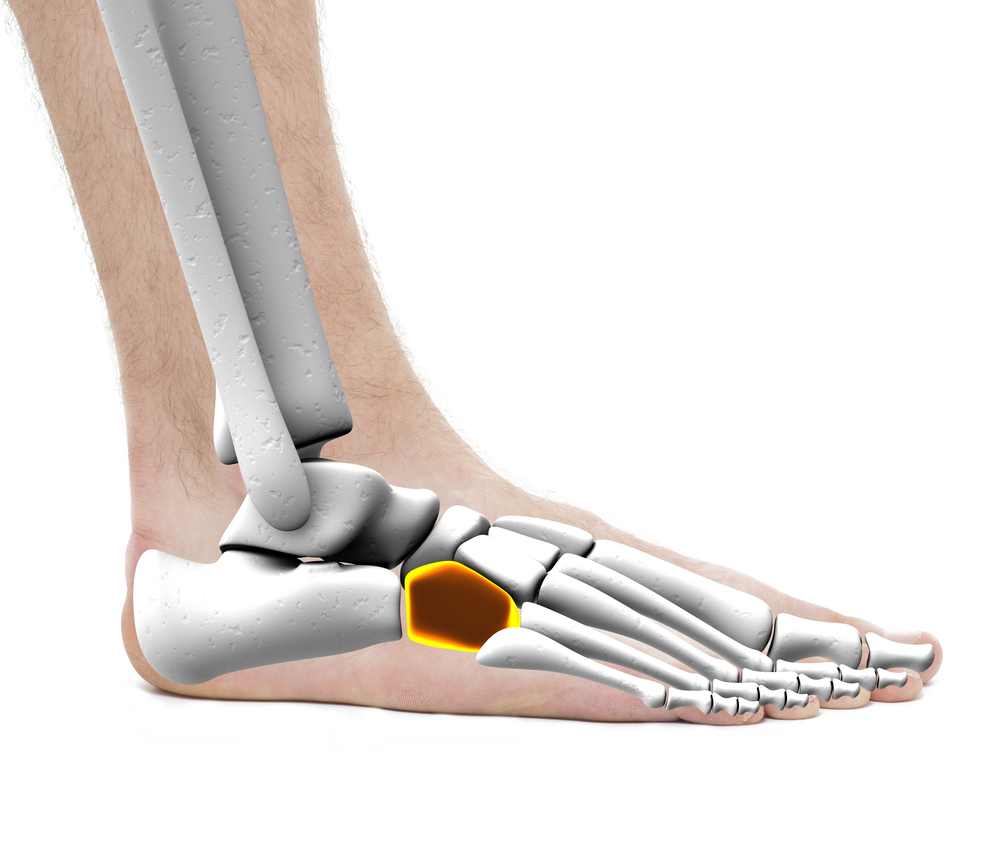
What is Cuboid Bone Fracture, and How Does it Occur?
Cuboid bone fractures, although relatively uncommon, typically occur due to various factors related to trauma and excessive weight-bearing. The cuboid is a tarsal bone located on the outer midfoot, and fractures of the cuboid often result from direct or indirect injuries.
- Direct Trauma: A direct blow to the outer midfoot region can lead to cuboid fractures. This can happen in accidents, sports injuries, or falls where the cuboid bone absorbs a significant amount of force.
- Indirect Trauma: Sometimes, cuboid fractures occur indirectly. This can be due to excessive or repetitive stress on the foot, such as from overuse, strenuous physical activities, or even improper footwear. The soft tissues surrounding the cuboid may also be strained or injured, leading to cuboid pain.
- Weight-Bearing: Activities that involve excessive weight-bearing or torsional forces on the foot, like running or jumping, can put the cuboid bone under stress. Over time, this may result in cuboid fractures or stress fractures.
- Foot Anatomy: The shape and position of the cuboid in the foot make it susceptible to injuries when the foot is subjected to certain types of trauma or repetitive stress.
Cuboid fractures can cause foot pain, swelling, and limited mobility. If suspected, it’s crucial to seek prompt medical attention as proper diagnosis and treatment are essential to ensure proper healing and prevent long-term complications. Treatment options may range from immobilization and rest to more advanced measures like surgery, depending on the severity and type of fracture.
What are some of the common symptoms of cuboid bone fracture?
Symptoms of a cuboid bone fracture can vary depending on the severity of the injury, but common signs include pain, swelling, and difficulty bearing weight on the affected foot. Here are more details on the symptoms associated with a cuboid bone fracture:
- Pain: Pain is the most prominent symptom. You may experience localized pain in the midfoot or outer foot area, particularly when bearing weight or during movement.
- Swelling: Swelling often accompanies the pain, and the affected area may appear swollen and inflamed due to soft tissue irritation.
- Bruising: Some individuals may notice bruising around the injury site as a result of blood vessels being affected during the fracture.
- Limited Range of Motion: Mobility in the affected foot may be compromised, making it challenging to move the foot as freely as before the injury.
- Difficulty Walking: Pain and discomfort can make it difficult to bear weight on the injured foot, leading to an altered gait or difficulty walking.
- Tenderness to Touch: The cuboid bone area may be tender to the touch, and pressing on it can elicit pain.
- Gradual Return to Normal: With proper treatment and rest, the symptoms of a cuboid bone fracture, including pain and swelling, should gradually subside. However, the timeline for recovery may vary depending on the severity of the fracture.
How can cuboid bone fracture be diagnosed?
Diagnosing a cuboid bone fracture typically involves a combination of clinical evaluation, medical history review, and imaging studies to confirm the diagnosis. Here’s how a cuboid bone fracture can be diagnosed:
- Medical History and Physical Examination: The healthcare provider will begin by asking about your medical history and the circumstances surrounding the injury. They will inquire about any symptoms you’re experiencing, such as pain, swelling, and difficulty walking. A physical examination will follow, during which the provider will assess the affected foot’s range of motion, tenderness, and any deformities.
- Palpation: The doctor will often perform a palpation, which involves gently feeling the cuboid bone area to check for tenderness or unusual sensations. A specific point of tenderness may indicate a possible fracture.
- Imaging Studies: X-rays are the primary imaging method used to diagnose cuboid bone fractures. X-rays can reveal the presence of a fracture, its location, and its severity. Sometimes, additional views or stress X-rays may be necessary to obtain a clear diagnosis.
- MRI or CT Scan: In some cases, if X-rays do not provide a definitive diagnosis, an MRI (Magnetic Resonance Imaging) or CT (Computed Tomography) scan may be ordered. These imaging techniques can offer more detailed information about soft tissue injuries, ligament damage, or complex fractures.
- Bone Scintigraphy: Rarely, a bone scan may be recommended to assess blood flow and bone activity in the affected area. This is typically reserved for complex cases.
Once the diagnosis is confirmed, the healthcare provider will determine the appropriate treatment plan, which may include rest, immobilization with a cast or boot, pain management, and, in some cases, surgical intervention for severe fractures. It’s essential to follow your doctor’s recommendations for treatment and rehabilitation to achieve a full recovery and prevent complications.
Is surgery a good idea for cuboid bone fractures?
Surgery is generally not the first-line treatment for cuboid bone fractures. Most cuboid fractures can be effectively managed without surgery, especially if they are non-displaced or have minimal displacement. The initial approach typically involves conservative methods such as:
- Immobilization: Placing the affected foot in a cast, boot, or brace to stabilize the cuboid bone and allow it to heal properly. Weight-bearing may be restricted initially.
- Pain Management: Over-the-counter or prescription pain medications may be recommended to manage pain and inflammation.
- Rest and Elevation: Elevating the foot and avoiding excessive weight-bearing can help reduce swelling and promote healing.
- Physical Therapy: Physical therapy exercises may be prescribed to improve range of motion, strength, and function once the fracture starts to heal.
- Follow-up Imaging: Periodic X-rays may be performed to monitor the healing progress and ensure the cuboid bone is aligning properly.
Surgery for cuboid bone fractures is considered when:
- The fracture is severe, with significant displacement.
- The cuboid bone is unstable and cannot be adequately realigned with conservative measures.
- There are associated injuries, such as ligament damage, that require surgical intervention.
Surgery typically involves realigning the fractured bone fragments and stabilizing them with pins, screws, or other fixation devices. The decision to pursue surgery is made on a case-by-case basis, and it depends on factors like the type and severity of the fracture, the patient’s overall health, and the goals of treatment.
It’s essential to consult with an orthopedic specialist or foot and ankle surgeon who can evaluate the fracture and recommend the most appropriate treatment plan based on individual circumstances.
How else can you treat cuboid bone fractures?
In addition to the mentioned treatments, other methods can help manage cuboid bone fractures:
- Casting Techniques: Orthopedic specialists may use various casting techniques, such as a short leg cast or a walking boot, to immobilize the fractured cuboid bone while allowing controlled weight-bearing as the bone heals.
- Orthotics: Custom orthotic devices, such as arch supports or shoe inserts, can help provide support and stability to the foot during the healing process. They are often used once the fracture has sufficiently healed to address any lingering issues with foot mechanics.
- Non-Weight-Bearing Exercises: While avoiding weight-bearing on the injured foot, you may be instructed to perform non-weight-bearing range-of-motion exercises to maintain flexibility and prevent muscle atrophy in the leg.
- Electrotherapy: Techniques like ultrasound therapy or electrical stimulation may be used to promote healing and reduce pain and inflammation in some cases.
- Follow-up Imaging: Regular X-rays help monitor the healing progress of the cuboid bone to ensure it aligns correctly.
- Nutrition and Supplements: Adequate nutrition, especially calcium and vitamin D intake, supports bone healing. Discuss with your healthcare provider if dietary changes or supplements are appropriate for you.
- Activity Modification: Modifying activities and avoiding those that exacerbate pain or place excessive stress on the foot can aid in the healing process.
- Comprehensive Care: In cases where there are associated injuries, such as ligament or tendon damage, addressing these issues alongside the cuboid bone fracture is essential for optimal recovery.
The specific treatment plan for a cuboid bone fracture will depend on the type and severity of the fracture, as well as the patient’s individual circumstances. Always follow your healthcare provider’s recommendations and attend follow-up appointments to ensure proper healing and recovery.

